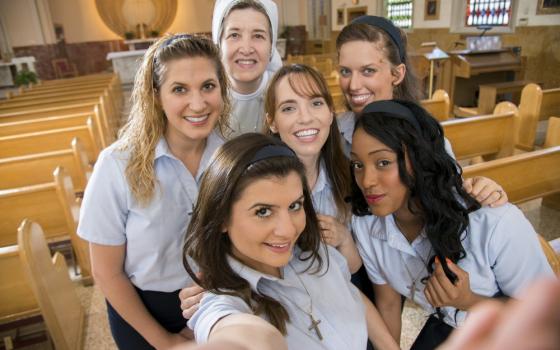Last spring, Lifetime TV began promoting a reality series called “The Sisterhood: Becoming Nuns,” in which five 20-somethings would visit three religious congregations and, at the end of six weeks, decide if they wanted to pursue religious life. When the series premiered at the end of November, it was to mixed reviews. Now that it’s over, the reviews are still mixed, but in the four weeks that it aired, some key themes emerged.
First, as the cameras showed Christie Young, Claire Halbur, Eseni Ellington, Francesca DePaola and Stacey Jackson living and serving alongside the Carmelites for the Aged and Infirm in Germantown, N.Y., and the Daughters of St. Mary of Providence in Chicago and the Sisters of St. Joseph the Worker in Walton, Ky., it became clear that the sisters were the real stars of the show.
Sr. Cynthia Serjak, director of the Sisters of Mercy of the America’s new membership office, was part of an active Twitter community that watched the show together each week, and she also blogged weekly recaps of the show. When she spoke to Global Sisters Report, only the episodes featuring the Carmelite sisters had aired, but Serjak had nothing but praise for them, even as she rated the show itself two out of five stars.
“I like the sisters,” she said. “The sisters come off as real people, and that’s one stereotype that’s important to break down.” As the series progressed, the celebration of the sisters continued, one viewer even going so far as to suggest on Twitter that the Daughters of St. Mary of Providence’s Sr. Beth Ann Dillon have her own show.
Some viewers were also dismayed that the show featured only sisters still wearing habits, but Linda Corley, the show’s supervising producer (and, incidentally, a lifelong Catholic who grew up in a school run by Adrian Dominicans), said that was not an intentional slight.
“The only thing that was very important to us was to show the broad spectrum of sisters in different ministries of life,” she said, “especially me, who was raised by unhabited nuns.”
However, when she began contacting communities, asking them to be on the show, no one would agree. Corley said it wasn’t until she connected with the Institute on Religious Life, a group promoting traditional vocations, that she was able to make any headway. As a result, all the communities on the show are affiliates of the Institute on Religious Life.
“Honestly, we invited the whole world. There was no discrimination whatsoever,” she said. “It’s just the ones that came forward happened to be habited. That’s all.”
But if the habits weren’t contrived, there certainly parts of the show that were, and some viewers – particularly some of the #RealNuns and #RealPostulants – were less than impressed. Discernment takes longer than six weeks, they said, and women do not drive all about the country in identical uniforms, jumping into ministries for which they are inadequately trained.
Linda Corely told GSR the show simply took the idea of a “nun run” and simply expanded it, but not everyone was buying it, including Audra Turnbull, a 26-year-old Immaculate Heart of Mary candidate.
“Do the nun run,” she said, “but don’t make them wear uniforms and give up makeup, or have all these other rules.”
Many critics thought the staged aspects of the show were proof that it was fake – that the girls were, at best, unprepared for discernment or, at worst, paid actors. But in the end (spoiler alert) Young and Halbur decide to continue the discernment process with the Sisters of St. Joseph the Worker and the Daughters of St. Mary of Providence, respectively.
Young told GSR that since filming ended this summer, she has sold most of her larger belongings and has moved home with her parents in order to save money and tackle her debt in preparation for entering the convent. Halbur has since returned to the Sisters of St. Joseph the worker for a retreat and a formal visit, and she is also still seriously preparing for religious life.
(The three girls who did not decide to continue the discernment process all took different paths: Ellington returned to her boyfriend, Darnell, and says they are planning a future together; DiPaola moved to New York to experience “post-grad” life, and Jackson – after briefly considering a vocation – says she now feels God calling her to be a wife and mother.)
It perhaps comes as no surprise that of the five young women on the show, both Young and Halbur had spent several years in visiting different communities before joining the cast of “The Sisterhood,” which is something Sr. Cecilia Ross, a Sister of St. Joseph the Worker featured on the show, would like to make clear. Furthermore, she said, it would be unfair to judge the women’s discernment process based on what was televised because not everything was filmed.
“Critics should be aware that the girls were at each convent for several full days – seven days in our case – and there were a lot of really meaningful conversations that either didn't make it into the final cut because of time constraints, or it took place off camera all together during break time,” she said. “In that sense, real discernment did take place in every convent. The girls had time for prayer and reflection. They had time to meet with the sisters, to talk to the sisters, to learn about the community.”
Ross says it’s also important to note that even the girls who did not ultimately feel called to religious life, saw the show as a means of evangelization.
“For them,” she said, “it was a ministry in a sense to do this project – to show that young people today still are considering a vocation.” It’s a motivation Ross, 24, can empathize with.
“I've been here with the sisters since I was 20 years old, and for me, it was really an opportunity to communicate that to people that young people today are still seeking something deeper and beyond ourselves,” she said. “For me that, was a really amazing opportunity.”
And that may have been the whole point. It may be that the primary concern of “The Sisterhood” was less about the five young discerners and more about the potentially hundreds of thousands of young Catholic women watching at home.
Corley said that when she was pitching the show to the Institute on Religious Life, her argument was this: If women religious want to reach Millennials, they have to speak to Millennials in their language. The message resonated with the Carmelites, who agreed to do the show only after much prayer and consultation with their lawyers.
“Lifetime Television has a membership of 2 million to 3 million women between the ages of 18 and 35, so to open a window to what our life is like to that group of women is an amazing opportunity for us,” said Sr. Maria Therese Healy, one of the Carmelites featured on the show.
But can the show like “The Sisterhood” really inspire new vocations?
Sr. Cynthia Serjak said that in the two weeks after “The Sistershood” premiered, views on the Sisters of Mercy’s “Become a Sister” page on the website were up 40 percent from the previous two weeks. And views were up 140 percent from the same time last year. Still, the only woman to mention the show just wanted to know how it ended, so Serjak was hesitant to draw a direct correlation.
Turnbull is also not convinced. If women religious want to reach her generation, she said, they need to be bolder. She first met the Immaculate Heart of Mary sisters because they invited her to visit, but that rarely happens anymore.
“I think women religious today have to find courage and believe that their way of life is a viable way of life to Millennials,” she said. “It’s not a confidence issue, but I think some of them have gotten so busy with other things, with fighting injustice, that they’re kind of forgetting to invite women to their communities. I don’t think the invitation is there anymore.”
She doesn’t discount the show’s potential to increase vocations, but she thinks there are also more viable options for women religious.
“It might get a few Millennials to start thinking about it, but our generation is also very socially conscious of what’s going on,” she said, “and I think a way to reach the Millennials is to be on the frontlines of those issues, which women religious are. I’m assuming that they’re probably in Ferguson, they’re in New York, they’re in the streets. They’re there.”
[Dawn Cherie Araujo is staff reporter for Global Sisters Report, based in Kansas City, Mo. Follow her on Twitter @ Dawn_Cherie.]

